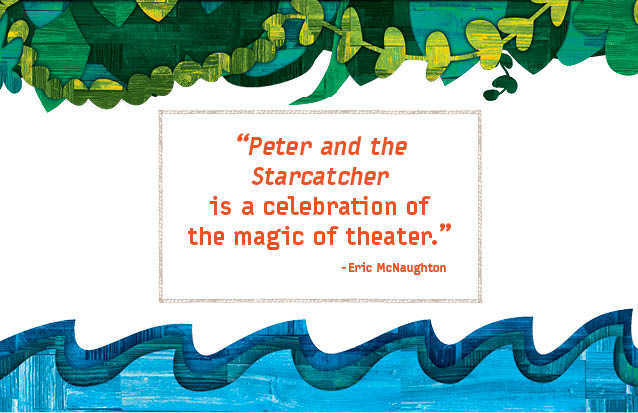The Benefits of Expanding ‘Peter and the Starcatcher’ For A Large Cast

I’m the Theater Director at Marist School in Atlanta, Georgia. We recently produced Peter and the Starcatcher.
It’s a show written to be performed by about a dozen actors.
We did it with 49. On purpose.

Marist School (Atlanta, GA)
First, a little background:
Our school produces about 4 shows per year for grades 7-12, and we have an unofficial “no cut” policy. Our school does not dictate that we do this, but we simply feel that it is the best idea for our community. Our students have a thousand choices when it comes to extracurricular activities, ranging from robotics and debate to sports and academic teams. Therefore, if a student comes to us and wants to be in a show, we work very hard to find a way to make it happen.
This is an easy practice when it comes to musicals; one can always expand ensembles, divvy up solos, etc. The challenges are a bit more pronounced when it comes to plays.
“[Peter and the Starcatcher] is also a celebration of what I refer to as ‘analog theatrical magic’ – no automation, no digital projections, no lasers.”
Since there are not a lot of plays that involve a large number of actors, we had to get really creative in our solution to the problem of how to reconcile our casting philosophy with scripts that don’t call for big companies. One can only do Our Town, Anatomy of Gray, and The Diviners so many times (there are certainly other shows that have large-ish casts, but you get my drift). Additionally, we want our students to have a meaningful experience in the show, and not just serve as “human set dressing” – “Hey, kids! We’re going to do The Glass Menagerie, and all of you will be portraying the glass figurines in Laura’s collection!”
Peter and the Starcatcher was the perfect piece for us. Though only written for a small company of actors, the structure of the show is such that there are dozens – if not hundreds – of opportunities to contribute to the storytelling in meaningful and important ways. The show is also a celebration of what I refer to as “analog theatrical magic” – no automation, no digital projections, no lasers, etc. Big blue silk sheets represent the ocean. Dozens of lanterns become the starry night sky. A jungle is populated by an army of creatures, creating a rich and diverse soundscape. And don’t forget the sailors, pirates, and mermaids. Lots and LOTS of mermaids.

Marist School (Atlanta, GA)
None of these are revolutionary ideas, but they can be employed with this script in a way that both involves a lot of actors and assists in the storytelling, rather than get in the way of it. Thankfully, we have the world’s greatest team: our technical director, music director, costume designer, choreographer, and scores of generous parent volunteers all rose to the challenge of doing this show in this way.
One other solution that we found to be helpful concerned the narration that occurs throughout the show. We found that spreading out the narration amongst the ensemble served several purposes. First, it gave lines to students who otherwise would not have a solo speaking moment in the show. Additionally, it prompted our audience to pay very close attention to the narration, as they had to follow their eyes and ears in order to know who was speaking. It also drove our actors to be very present, clear, physical, and, frankly, loud in order to distinguish themselves as that moment’s speaker.
“…our cast is a team. We all work together to create something that is larger than ourselves, and each actor/component/element is valuable.”
One of the big themes in our work here is that our cast is a team. We all work together to create something that is larger than ourselves, and each actor/component/element is valuable. When the narration is spread out amongst the company, the action grinds to a halt when someone isn’t there to do their part. When someone isn’t there – mentally or physically – to hoist a drape or manage the shadow puppets, the story is interrupted.
Were there hiccups? Absolutely. We used a massive green drape to suggest the jungle in Act II, and one night the preset was incorrect and it got tangled up while rising in the air. It only delayed us for about 45 seconds…but it felt like 45 minutes. The magic of this particular problem was in watching the ensemble quickly diagnose the issue, come up with a solution, and continue with the story – all while keeping it in the world of the play. Another benefit of having a lot of actors in this show was that there were always a lot of hands available to help out in a pinch.

Marist School (Atlanta, GA)
At the end of it all, Peter and the Starcatcher is a celebration of magic: the magic of youth, the magic of belief, the magic of friends, and the magic of theater. The Broadway production that I saw was absolutely magical for its doubling, quick character work, and stunning environment. Our students grabbed a few handfuls of starstuff and worked their own magic with this show. The waters may have been a little rough at times, but I cannot imagine navigating them without all 49 of them.
Eric McNaughton
Eric McNaughton holds a B.A. in Theater from Wake Forest University, and apprenticed at Actors Theatre of Louisville. He is the Theater Director at Marist School in Atlanta, GA, where he has worked on over sixty plays and musicals as tech director, co-director, or director. During the last few summers, he has performed at Lyric Theatre of Oklahoma, in shows ranging from Ragtime to Big Fish to Les Miserables. Last summer, he worked as Assistant Director for Disney’s When You Wish: A Celebration of the Disney Songbook, also at Lyric Theatre of Oklahoma.